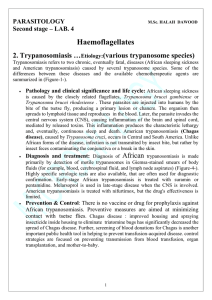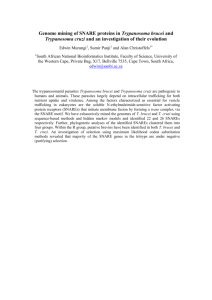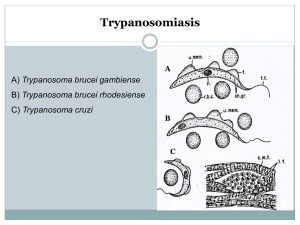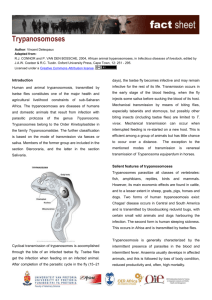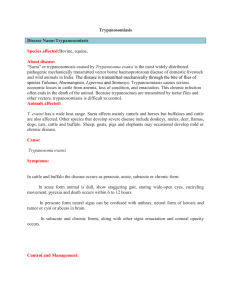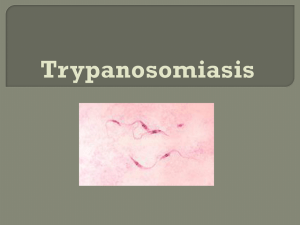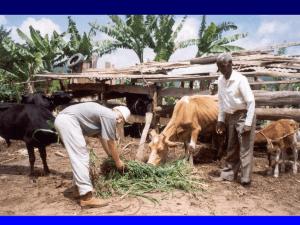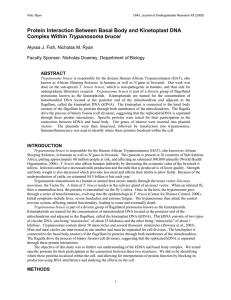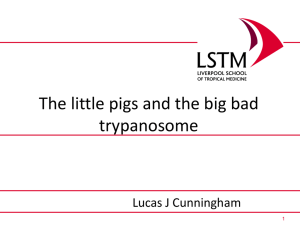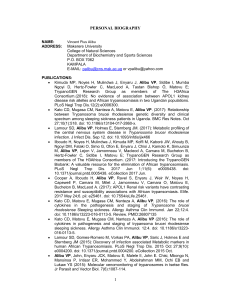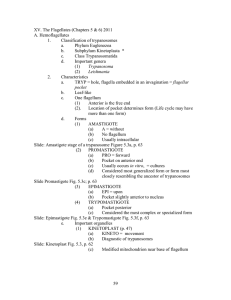Trypanosomes
advertisement
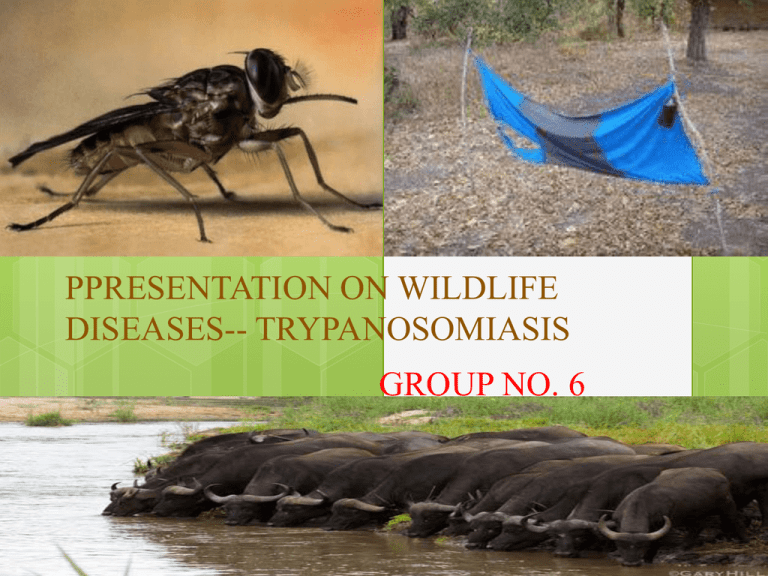
PPRESENTATION ON WILDLIFE DISEASES-- TRYPANOSOMIASIS GROUP NO. 6 INTRODUCTION. Trypanosomiasis o Is a disease caused by protozoa parasites known as Trypanosomes of species Trypanosoma brucei and Trypanosoma vivax that are primarily transmitted by tsetse flies Glossina spp, and can infect a wide range of wild mammal species but these are mostly trypanotolerant and also affect almost all domestic mammals and human. o There two subspecies of the parasite that are responsible for initiating the disease in human, Trypanosoma brucei gambiense causing a disease in west and central Afrca, Trypanosoma brucei rhodesiense causing a disease in east and southern Africa. o The third subspecies Trypanosoma brucei brucei is responsible for affecting animals and not humans. CONT…………….. The other species Trypanosoma vivax is a parasite in the genus Trypanosoma. Cause the disease Nagana, also known as animal trypanosomiasis, affecting cattle and wildlife mammals. It mainly occur in west Africa, although it has spread to South America. GEOGRAPHICAL DISTRIBUTION o Trypanosomes can be found wherever the tsetse fly vector exists. Tsetse flies are endemic in Africa between latitude 15° N and 29° S, from the southern edge of the Sahara desert to Zimbabwe, Angola and Mozambique. Geographical distribution CAUSATIVE AGENT AND MODE OFTRANSMISSION Causative agent o Trypanosomes, protozoan parasites of the genus Trypanosoma that live in the blood, lymph and various tissues of vertebrate hosts. The most important species for this disease are Trypanosoma vivax and Trypanosoma brucei. Mode of transmision o Trypanosomes must first develop within tsetse fly vectors for one to a few weeks. They are then transmitted through tsetse fly saliva - when flies feed on an animal they inject saliva before sucking blood. Tsetse flies will remain infected for life. Trypanosomes can also be mechanically transmitted by biting flies when these flies transfer blood from one animal to another. Mode of transmission cont….. SYMPTOMS o o o o Changes of behavior, confusion, sensory disturbances and poor coordination, Disturbance of the sleep cycle. CLINICAL SIGNS o The primary clinical signs are an irregular fever, signs of anemia, lymphadenopathy and weight loss. Animals lose condition and become progressively skinny. Milk yield may be decreased in dairy animals, , diarrhea, keratitis, lacrimation and appetite loss. DIAGNOSIS o o The disease should be confirmed by health professionals identifying pathogenictry panosomes in blood or lymph node smears. Anticoagulated fresh blood, dried thin and/or thick blood smears, and smears of needle lymph node biopsies can be submitted from live animals. Trypanosomes are most likely to be found in the blood by direct examination during the early stages of infection. They are less likely to be detected in chronically ill animals, and are almost never seen in healthy carriers. Xenodiagnoses (looking for the parasite in a previously uninfected vector which is exposed to the host, rather than the host itself) is also a useful technique when attempting to isolate from wildlife. Samples should only be sent under secure conditions and to authorized laboratories to prevent the spread of the disease. Although the trypanosomes that cause African animal trypanosomiasis are not known to be zoonotic, precautions are recommended. AFFECTED WILDLIFE SPECIES o Wild animals known to be infected but which are trypanotolerant include greater kudu, warthog, bushbuck, bush pig, African buffalo, African elephant, Black rhinoceros, lion and leopard. o Several species of wild animal appear not to be trypanotolerant, e.g. the southern white rhinoceros can die from infection. THREATS TO WILDLIFE o It pose a substantial threat to the conservation of global biodiversity. o Wild animals rarely show clinical signs of trypanosomiasis but wildlife hosts are a reservoir of trypanosomes. Some species such as southern white rhinoceros, which prefers open grassland, can suffer mortality from the disease. DISEASE MANAGEMENT IN THE WILD o In endemic areas of Africa, African animal trypanosomiasis can be controlled by reducing or eliminating tsetse fly populations with traps, insecticides and clearing of bush, and by treating infected animals with antiparasitic drugs.(e.g. diminazene aceturate and quinapyramine methylsulfate). Control of tsetse fly in the wild CONCLUSION It seems that this disease is very dangerous to animals and human being especially for those who are working in Protected areas or leave in rural areas. It needs more research for effective treatment in order to reduce the number of death. Trypanosomiasis must be reported to state or federal authorities immediately upon diagnosis or suspicion of the disease.

